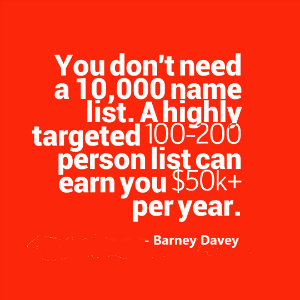You Can Succeed Selling Art with a Small Email List.
This post is inspired by Seth Godin’s post titled, “Average is not the same as typical.” His thoughts align with mine when he talks about marketing to the smallest possible audience. I call it a small but mighty email list. Either way, we agree that a small, loyal list is an excellent choice.
Seth also emphasizes that average is different from typical. Think of it this way for a visual arts perspective:
The average art buyer may buy one or a few originals in a lifetime, but a typical collector buys multiple pieces multiple times. Marketing your art is less confusing when you realize that starting by building the smallest viable audience is the best thing for you to do.
Visual artists’ advantage.
Of all the arts and practically any business for that matter, visual artists need the smallest group of buyers to create long-lasting success. Think about it. Authors, musicians, playwrights, and filmmakers all plan to market the fruits of their creativity to thousands, tens of thousands, and more to create the success they desire.

Visual artists with large ambitions need 1,000 true fans, or more. But you choose your level and then scale according to your needs either way. For example, since this post is about small email lists, you might do all you want and be happy with fewer than a hundred subscribers. Think about how you can cater to such a small, mighty group. Email would be the glue for engaging and doing other cool, almost custom things with your PoP (Pocket of People).
Learn All About Email Marketing for Artists.
If you want to learn more about how to use email in your art business, check out this comprehensive post, The Definitive Guide to Email Marketing for Artists. The guide is full of useful tips, insider information, and good ideas that will help you do well with your email marketing plans.
You can crush it with a small list!

Have you taken the time to break it down? Do you know how many sales at what price you need to bring in a specified annual income? The graphic here mentions $50,000, but you can choose any figure you like.
For example, using a $50,000 desired annual income and a modest, average price for your originals of $1,800, you need about 28 sales made directly to patrons to hit your target. Hitting those targets requires hustle, at least at first, but it’s doable.

Numbers you need to know.
Average direct marketing gets a 4–5% sell-through rate from a list. At that rate, you’d need about 700 people with some degree of interest on your list to sell 28 originals. However, this is an average, and your results will most likely differ significantly.
Another way to see it is you need four people from every hundred on your list to buy an original from you in the next 12 months. If your list is curated, getting a 4% sell-through is more than possible. One-in-25 is all you need. Making learning how to get the right people on your list a priority and put in the work to keep them on it is to create unstoppable success.
Why email marketing for artists matters
Start with this truism. Most of your sales will go to people who only buy original art a few times in their lives. Art rarely is a spontaneous decision. It’s an expensive purchase that usually requires spouse/partner approval, often including where to display it. Experience shows your best prospects may know and like you, they may love your art, but they don’t have an urgent need to buy original art at the moment. So, what is an artist supposed to do?
Email keeps you in touch to your list no matter the size.
The answer is to get them on your email list. That is the best and perhaps only way for artists to stay in touch with potential buyers and keep them engaged with the content they send through email marketing. Yes, social media helps, but there is so much the artist can’t control with resorting to advertising that can get expensive fast.
Sending email messages biweekly is how to keep prospective patrons interested in you and your art while buying decisions brew. Set a publishing schedule and create a topic list to know when and what you will publish. Mix in at least two of the four EDIE (educate, demonstrate, inform, and entertain) attributes with each post. It’s best not to always ask for sales with every email.

Do it both ways.
You don’t have to choose between making a large and a small list. If you concentrate on creating a small, mighty list, it can grow into a more comprehensive list as a happy byproduct. A small, robust list is one where your prospective buyers and active patrons are highly qualified. They have shown, or you have created in them, an interest in your work that goes beyond casual. Most buyers of art who are not collectors of art are casual. They don’t take collecting art seriously, and they usually only buy when they have a particular need.
There is no reason not to have casual buyer prospects on your list and keep them warmed up for the day when they need a piece of art. Still, keep your focus on building a list of people who will take an active interest in you and your art. They are the most likely to purchase multiple artworks from you. These patrons will help you advance your career in other ways, such as by making introductions to influential people. It’s a probable outcome that your happy patrons will buy three, four, five, or more pieces of your art throughout your career.
That sounds hard.
It’s true that finding ideal buyer prospects and connecting with them is a challenge. But, consider the alternative, which is selling your art to strangers. No matter how you slice it, selling to strangers is the most complicated. Having someone else make sales is why some artists want to work exclusively with galleries. While there is nothing wrong with working with galleries in general, it’s far from ideal.
First, you need a string of galleries to sell all your art. Second, you have to make and then sell twice as much artwork to earn the same as selling to patrons directly. Third, there are not enough of them to go around. There was never enough even in the best of times for the gallery business, and we’re far from those days. Nevertheless, we know they’re not coming back. Lastly, you give up control of your distribution when you work exclusively with galleries or other third-party distributors. And that is a situation fraught with peril.
Start thinking about direct patronage.
I suggest you read this post to learn more about direct patronage. It is the small, mighty list concept. The reason I strongly advocate this approach is that I don’t see a better solution for artists. If you want the best for your career, then nothing beats selling most of your work to people who know you, love your work, and want to support you.
Besides being the best thing, you can do financially for your career, I believe having closer contact with your buyers is fulfilling, heartwarming, and soul-satisfying in ways that are incomparable to others.
A gallery selling your work is, at best, a pleasant thing. You eventually get your cut of the sale, but you get little, if any, feedback and have zero personal interaction with your would-be patrons. Galleries consider the buyers who purchase your art as their clients and not yours. As such, the experience doesn’t come close to selling your art with a passion to those who love it.
Next steps.
Marketing your art is a lot like making it. Before you get started, you have to make decisions. Yes, you can sometimes achieve exciting results by letting your muse wander. However, having a plan and sticking to it will help you get more done and have more rewarding results in the long run.
When it comes to getting your work to market, the better your plan, the better your results. If you work at building an ideal client avatar and then focus on marketing to those who closely match that ideal, you will get faster sales and higher returns on your efforts than by doing anything else.
Small but mighty is powerful.
You don’t have enough time or money to market to everyone. It would be hugely wasteful even if you did. So why not turn your attention to making a plan to build a small, mighty list and then acting on it with zeal? That’s your key to success—the kind of self-made success based on marketing and relationships that you control that cannot be taken from you like those with third parties can.
Unlock Your Creative Potential.
Do you love what you do but have trouble growing your audience? Join the AMXtra global collaborative community of visual artists learning to sell and market their work online and in-person.
My goal for AMXtra is to make quality art marketing advice available and affordable for all artists of every level everywhere.
Practical art marketing insights and helpful ideas.
Art Marketing Extra (AMXtra) is a twice-monthly exclusive newsletter for visual artists. Each issue comes with a livestream that you can interact with, as well as a large library of art marketing workbooks and training videos. You’ll get helpful marketing strategies and tips. And you’ll learn new ways to sell more art, develop deep relationships with your audience, and boost your reputation.








